by David Bush, Ph.D.
It is my privilege to share one school’s experience at the Johnson’s Island Civil War Prison. The Lorain County Early College High School brought four classes to the Johnson’s Island Civil War Prison site in April, 2010 through Heidelberg University’s Experiential Learning Program in Historic Archaeology. Their teacher, Mark Jaworski (Lorain City Schools), worked with the students on various types of projects to introduce them to the many forms of information available for this Union prison. Mark prepared several work sheets for the students to assist in exploring issues like common diseases, historical facts, vocabulary, use of primary source materials, and even the location of William Peel’s grave in the Confederate Cemetery. All of this pre-field preparation paid off, for his student’s were some of the best prepared and most inquisitive 9th graders we have had this year.Â
I thought I would review briefly the daily routine for students participating in the Experiential Learning Program in Historic Archaeology. When the students arrive on Johnson’s Island, their first introduction to the site comes in the form of making Anthropological observations within the Confederate Cemetery and hypothesizing about these above ground artifacts from the past. Students walking through the cemetery almost always note the two basic styles of the tombstones, the numerous stones marked only with the word “Unknownâ€, and the absence of any form of date on the grave stones. Over the years, I have been able to identify over 40 observable patterns within the cemetery, and there are probably more. The students form hypotheses about these observations, noting several different hypotheses can be proposed for any one observed pattern. As they present first their observations and then their hypotheses, we explore the differences between something observed and the conclusions we draw from an observation. We further discuss how to investigate our hypotheses, where to go, what kinds of sources are appropriate to use. In the end, the students gain a glimpse of how Anthropologists use observation as a means to interpret cultural landscapes (the cemetery in this case).Â
There is a very short bus ride (about 1/2 mile) to the site of the actual prison, where the students begin the archaeological exploration. Orientation to the site takes about 20 minutes where the basics for establishing provenience are reviewed and appropriate excavation and recovery techniques demonstrated. The students (in groups designated A, B, C, or D-corresponding to specific units) are then ready to meet with their Unit (the 2m square they have been assigned to) supervisor to begin excavation and cultural material recovery. The majority of the day is spent in the recovery of the multitude of cultural materials at this site and hypothesizing about the type and function of each artifact encountered. To facilitate this process, a form of Dig Bingo is played.Â
At the end of the day, the Unit supervisor gathers together the student personnel for their Unit and reviews and records all the findings. Hundreds of artifacts are typically recovered each day, ranging from chert and flint used by the Native American inhabitants centuries ago to the brick, bone, glass, ceramic and craft pieces left behind during the American Civil War. At the very end of the experience, a student from each Unit shares with the entire class a particular artifact they felt was the most interesting. This can be a very challenging task at times, given a Unit may have revealed over 200 artifacts in one day’s excavation.Â
Mark had his students prepare reports on their experiences.  He has shared portions of them with me to bring to the Interactive Dig. I hope you enjoy reading them as much as we enjoyed having all these students share this experience.
 Experiential Learning Program in Historic Archaeology-The Johnson’s Island Civil War Prison Site
Â
The following provided by:Â MARK A. JAWORSKI, Biology Teacher, Lorain County Early College High School
 Lorain County Early College High School Biology teacher, Mark A. Jaworski, and his students had the opportunity and privilege to participate in four historical archaeological digs on Johnson’s Island this past April, 2010.
 “Teaching children about the natural world should be treated as one of the most important events in their lives.â€Â Thomas Berry
 I would like to share not only photographs of our experience but reflections of some of my students who participated in these digs.
Alex  Fulton (female) writes, “The archaeological dig at Johnson’s Island was a very memorable experience. Being able to walk in the cemetery, three feet above the remains of the deceased soldiers was absolutely incredible. As we walked across the cemetery, I could feel the sadness in the air and it made the hair on the back of my neck stand on end. …In the cemetery, we found that the primary source, MacDowell, who stated in his diary that William Peel was buried in the fifth row from the south gate, twenty-eighth grave counting from the west. Peel’s headstone was in the sixth row from the south gate, third counting from the west. A headstone bearing the name of J. D. Arlington was placed over William Peels burial site.           On our short walk through the woods to the dig site, we passed the red poles marking the dead line. When we walked past those red markers, I could imagine myself being a confederate soldier and having that fear of crossing the dead line - that fear of being shot! I could envision myself wanting to escape, being close to escaping, and just having one thing stop me – that dead line. The yellow and blue poles marking the corners of the barracks were also amazing. I could picture in my mind the prisoners sitting inside the buildings in the winter, shivering, while writing letters to loved ones.â€
 Hector Toledo writes, “ Once we got to the dig site we met the crew that would be helping us and working with us. They seemed very professional and would prove to be very helpful. In the end I was very thankful to of had the opportunity to participate in this dig. I felt that I got to take part in unfolding a little piece of the past. I hope to participate in Johnson’s Island research because it truly was an enriching experience.â€
Phylicia Thomas writes, “ I was amongst the people allowed into Dr. Bush’s office for finding a special field specimen! My day was golden. Completely. I had just done something I had wanted to do every second since I had heard of this trips forthcoming! I sat in his office, answered the routine questions and filled out paperwork as he spoke to me about the piece of embossed glass I held in my hand. He explained to me that it was a piece of the shoulder of a patent whiskey bottle. On this tiny piece of glass, one letter was raised; a “T†and what looked like the beginning of an “E†to spell the word P-A-T-E-N-T. This was a piece of evidence that would help them prove the theory that the tiny little area we were excavating was the remnants of a kitchen area. He handed me a sticker and I filled out the rest of the paperwork and looked at my artifact number one last time #8122. This artifact would be placed with my name under it in the Heidelberg University archives. Yes, I decided at that moment, today was perfect.â€
Leah Rumph writes, “ I soon arrived at the cemetery. I was trying to locate the grave of William Peel.   I was standing on the graves of men who believed that people of my race should do inhumane labor for people of his (Peel) race.â€
Brittany Pirl writes, “To dig for long lost artifacts, left behind by someone whose views were so different from ours is an amazing experience. It is an experience that many never get to take part in during their lifetime. Archaeological digs allow people of the present to learn about those of the past who have long been forgotten. They tell us much about people, their views, beliefs, and their culture that, without the information found, would never otherwise be known. “
Gabby Ocasio (as a ghost returning to the island) writes, “I went back to my block 8 today. It is all gone and all that remains is dirt and pieces of my personal affects everwhere. There were these strange people in different clothing with weird haircuts and bright colors and very strange shoes. The females wore bows in their hair and the males wore ear rings. The people looked like mostly teens and older adults. They came from this huge strange, bright yellow, gassy animal that looked like it had huge wheels where its legs were supposed to be.   What I had noticed was that they must have been looking for my block mates and my belongings since they were ecstatic when they found something. I do not understand why they would be looking in the dirt. Then they found something very peculiar, a piece of plate. This had brought tears to my eyes. It was my great grandmother’s favorite plate that she had given me when she was on her deathbed. She made certain that it was sent to me for she had heard of my imprisonment on Johnson’s Island. I had always made her hard rubber jewelry to wear around her neck.â€
Kyndra Downey writes, “When it was time for lunch is when I really let my imagination take over. Dr. Bush and his assistants read journals/letters from prisoners housed on Johnson’s Island. As they were reading to us, I just let my mind wonder and really put myself into the prisoner’s position. …I know that I am very grateful that I had the opportunity to participate in this historical archaeological adventure. I think I am going to consider archaeology as a career choice.â€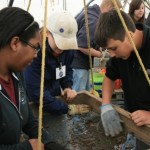
Benjamin Tillman writes, “At lunch I could take in the history of the island very effectively and journal entries from some confederate prisoners were read as well.  This was very interesting because I could hear exactly how the prisoners were feeling and what they were doing in prison. The readings put into perspective that these were real people being held at this prison. It wasn’t just words in a book to me anymore. It was reality, a cold hard reality that I could feel.â€
Victoria Soewarna sums it up best when she writes, “ This experience for me was amazing and overwhelming at the same time, the view of Lake Erie was beautiful, the stories that were told from the diaries of the imprisoned soldiers were heartfelt and the artifacts told a story. A story that I personally will always remember.
(DRB note) Thank you Mark for providing such a rewarding experience for your students.

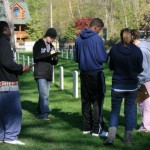
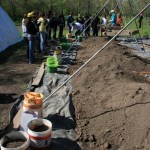


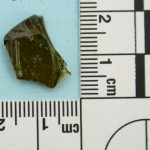
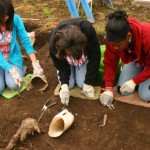

Mark,
Your students responded so insightfully to the dig! As a credit to you, you set the tone for the type of experience your students had with preparation and enthusiasm. Thank you for optimizing the learning potential of this program for your students!
When we went to Johnson’s Island it was an amazing experience and a once in a life time chance. The first thing we did when we got there was go to the cemetery. It was scary to think we were walking over the graves of confederate soldiers. We looked for patterns and made inferences and hypotheses. One pattern was the names on the marble gravestones faced south. I inferred the names were placed this way because the confederate soldiers were from the south. However, I learned that the original gate was facing south, toward the prison thus making the entrance into the cemetery easier.
“The cold rain fell hard upon on us as we walked into the Johnson’s
Island cemetery. This is where all the dead bodies of Confederate
soldiers who supported slavery were buried. We didn’t stay long
because the rain made the ground soggy and it was cold. We hopped on
the bus and headed toward the digging site. On the ride to block eight
we saw mansions along the bay with spiral stair cases leading to the
quarries. We finally made it to the digging site. Everyone grabbed
their gloves and stepped off the bus. Dr. Bush lead us into the tent
with some students from Heidelberg University…”
I am really happy that I had the chance to experience this archaeological dig. I had no idea that I would enjoy it so much. My first thought about the dig was, “I’m probably not going to find anything, so don’t get your hopes up.” But it was the total opposite. I found artifacts; window glass, nails, brick, and bones. The one that excited me the most was the part of a can. I first thought it was a piece of weirdly deformed rock but when I tested it on the magnet, I found out it wasn’t a weird rock, it was metal! I asked Sarah (Heidelberg student helper) and she said it was a piece of can. I never knew that there were cans back then. I am so happy I went! I am considering archaeology as a career when I am older.
The cold whispers of wind that blew across the cemetery sent chills down my spine. It reminded me of all the soldiers that lost their lives in the Civil War. When we walked through we observed various patterns of the graves. Our first observation was that William Peel was not burried under his grave-stone. This was verified by a primary source, MacDowell. Overall I really enjoyed participating and digging!
Johnson’s Island was truely an amazing experience. It was so amazing to stand in the graveyard about four feet above these people who died for what they believe in, and just to think of how these people lived and died on this island. Then to be able to dig and shift though the dirt trying to find something that was maybe once valuable to these men was terrific. Then as we were eating lunch we were read letters and journals of these men and to try and put yourself in their position. I had a wonderful time at Johnson’s Island an experience I hope other will be able to experience aswell and I would like to go back someday.
When my class and I visited Johnsons Island we had background knowlegde about the war and the prision itself. We had read books and journals from the prisioners. We all really thought that this experience was a very interesting and a great oppurtunity for get to know the field of Archaeology. There were many things that I learned and I am now very interested in finding more out on this very appealing topic. I really recommend this experience for other people who have an interest or even thinks that this information is interesting.
My experience at Johnsons Island and all of the information I learned before the trip was incredible! I was very excited to visit the island and look for artifacts from so long ago. When you really think about the things you have found it was amazing getting to imagine what they were used for. The cemetary gave off an erie feeling, just thinking of all the soldiers buried there, and all of them probably not all confederate soldiers but union soldiers as well. When you think about the fact that all of thiose men faught for what they wanted this country to be. My visit to Johnsons Island is one I will never forget.
Dave–as a supporter of your work at Johnson’s Island, this discussion means the world to me. My first field school experience was in the later 1970s…30 years ago or more…at a Miami Indian site on the Mississinewa in central Indiana. It is really rewarding to see the same enthusiasm I had back then being expressed by these young scholars today. I am pleased to be among the numbers of Friends of Johnson’s Island. I hope all who are following your work here on the Archaeology website consider helping out as well by giving at http://www2.heidelberg.edu/johnsonsisland/.
Best,
Mark Rose, Archaeology Magazine
What great comments from these young people! They are living proof that this country will be in good hands in the years to come! I love their enthusiasm….
Mark,
My first professional excavation (1970) was in England on an Iron Age hillfort. I was just going to start college and the excavation convinced me to embark on a career in Archaeology. However, my interest started when I was in high school, and it has only grown over the many years. I am positive two factors contributed to the wonderful experiences shared on this page. The Experiential Learning Program we have developed at Heidelberg University offers many possibilities for getting our younger students excited about their past. The second factor is the vision of their teacher, Mark Jaworski, in taking advantage of the multi-disciplinary nature of this experience. Combined, it brings a context the students can be immediately drawn into. On behalf of Heidelberg University, the Friends and Descendants of Johnson’s Island Civil War Prison, Mark Jaworski (and the Lorain County Early College High School), and the history we unearth each day, we thank you, the Archaeological Institute of America, and Archaeology Magazine for supporting this work.
Dr. Bush and Mr. Jawworski, I was “blown away” by the wonderful and articulate comments of the students. As one student noted it was ” a golden day.” for her and I must add that reading all the student’s reactions to the experience made it a golden day for me.
Ms McFarland:
Please read your history. Not all Confederate soldiers “supported slavery” as you say (nor were all Union soldiers anti-slavery.) Actually, only approximately 5% of CS soldiers owned slaves. Not only did not all CS soldiers support slavery, not all of them even supported secession. What all of them did support was the right of their state to determine its own form of governance as their forefathers did from England, and when a majority of the citizens of their state seceded and was invaded by the US military, they took up arms in what they felt was the defense of their homeland.
Gen Robert E Lee was anti-slavery and anti-secession. In a letter to his son in 1861 he lamented the dissolution of the Union and said that he would sacrifice all he had “except my honor” for its preservation. He then said he was returning home to Virginia “to share in the miseries with my people.”
SM Hood
Huntington WV
Mr. Hood,
I totally support your comment on this web site. Too few are taught that “States Rights” was the impetus for our “Civil War”. It began as an ECONOMIC conflict a battle for equal representation in the unified “states” government, between the industrial Northern States the agricultural Southern States. Slavery became the rallying cry 2 years after the war’s beginning when President Lincoln searched for, and found, a rallying “ideal” for the Union
Army.
Lee Vanderhoef
Keswick, VA
Mr. Vanderhoef,
You’re right about the lack of education in public schools everywhere about the Civil War or War Between the States. However, you’re wrong about the direct cause. All one has to do is study the great political debates and ultimate compomises from 1820 to 1860. All were about Slavery. If there had been no Slavery issue there would have been no war. In fact, no less of an authority than Dr. James Robertson of Virginia Tech will tell you the same thing. Slavery was “the” issue that could not be compromised under States Rights as it was indeed a “right” allowed under the Constitution at that time. It was also an “Economic” issue because so much of the wealth of the South was tied to slavery and to the slaves themselves. If a way had been found to provide restitution to the slave owners to compensate them for the loss of their slaves then perhaps the war could have been avoided but that obviously didn’t happen. If you read the Declaration of Secession from South Carolina it speaks of nothing but slavery. Same for Mississippi. The majority of the same declaration from Texas also is about slavery. No one can honestly say that slavery was a non issue or an issue that didn’t come up until Lincoln issued his Emancipation Proclamation. The latter was a political instrument but nevertheless pointed out the obvious. There are just too many in the South even today who just won’t accept facts when it comes to what ultimately caused the breakup of the Union. Every time I hear some member of the SCV give a speech about how slavery had nothing to do with the War I can only hope that one day the ignorance ends.
When I grew up I was taught that Abraham Lincoln freed the slaves, the South wanted to keep them in bondage and tried to form a new country to retain their slaves. The Civil War was then fought.
Students today should fully read the Emancipation Proclamation and note that it is dated on Jan 1, 1863, a year and a half after the Civil War started. How could this be if the war was about slavery? Many famous battles had already been fought before Lincoln freed the slaves: First Manassas (Bull Run), Gaines’ Mill, Malvern Hill, Second Manassas (Bull Run) and the bloodiest day of all, Antietam.
Most importantly students will read in the Emancipation Proclamation that Lincoln DID NOT FREE ALL THE SLAVES! He freed only the ones in areas of the South that were not under Federal control. Slaves in Kentucky, Maryland and Missouri were not freed by the Lincoln because those states did not officially secede. Even more shocking to most people is that Lincoln exempted from emancipation any and all slaves living in certain areas of the Confederate states. Slaves in certain counties of Virginia, Tennessee and Louisiana were NOT freed by Lincoln because these areas had many Union sympathizers. Lincoln freed only certain slaves in specific areas because he wanted to disrupt the economy of the areas of the South that rebelled. If Lincoln wanted to free slaves due to humanitarian reasons he would have freed them all.
Slavery was not legally abolished (by Federal law) everywhere in the United States until 1866, a year after Lincoln’d death.
Very interesting. I have been to Johnson’s Is years ago. And my Gt Gt Grandfather was a POW there during the Civil War. They say he walked home to Virginia but was sick and never fully recovered. His name was Charles Henry Duvall, he was a Lt with Company D, 31st Va Militia.
We do have a C. H. Duvall on our prisoner list. He was captured in 1862 and sent to Vicksburg for release in September of 1862 with most of the prisoners at that time. I am wondering if you or your family have any records of his stay at Johnson’s Island? We would love to have a picture of him or copies of any letters, diary, etc. that may exist. Thanks for sharing.
I’ll make some inquiries, but unfortunately that branch of the family is a little distant. The Society for the Descendents of Mareen Duvall is in MD and Charles was from that line. His family was from Winchester, VA during the war.
It is really interesting to study archaeology because you would able to discover new things. You would able to conduct some experiments and other discoveries in order to know something. I had already read the great works of some famous archaeologist and it is truly fascinating.
Splendid writing! Though I’m more interested in the beautiful theme you’re using, mind sharing the title?